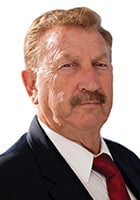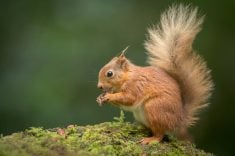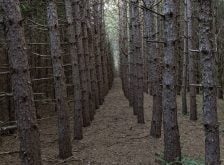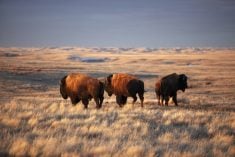When I moved from Guelph to Edmonton in 1974, I quickly found out Alberta had the world’s biggest and most innovative game farm. It was called the Alberta Game Farm, later called Polar Park, some 25 km west of the city. This farm, situated on 500 hectares (1,236 acres), was truly incredible. The huge open-air farm housed hundreds of different species, amounting to over 3,000 animals in heavily fenced open fields or large compounds. You could buy food to feed the various animals and, in some circumstances, get as close as one could ever believe.
I’ll discuss Al Oeming’s game farm later in this text. Who would even want to go on an African or Indian safari when the Alberta Game Farm had it all and much more conveniently?
Presently, game farming on the Prairies, and in Canada from coast to coast, has become serious business ventures for thousands of individuals or conglomerates. Bison (buffalo) farming is classified as game farming, with some 150,000 bison on close to 1,000 farms across the country — in actuality, from British Columbia to Quebec. Some 90 per cent of those bison herds are located on the Prairies.
Read Also

Gentle treatments for pain in the neck
Heading toward year-end, people unknowingly tense up against the cold and busyness, causing neck pain that can often be treated with appropriate support and gentle mobility, athletic therapist Kathlyn Hossack says.
While the term “game farm” brings to mind elk (Wapiti), white-tail deer and caribou, in reality some game farms are licenced to have fallow deer, moose, mule deer, reindeer, bighorn sheep, thinhorn sheep, musk deer and even mountain goats. Those are by no means all of Canada’s game farms; some have 200 or so acres of land for pheasants, quail and partridge. A few of these bird farms allow shooting for hunters with the intention of training retriever dogs.
Alberta has the largest number of game farms, at around 250, and also the largest number of bison and elk. Saskatchewan is close behind in numbers, with lower amounts in Manitoba and British Columbia. Saskatchewan allows game hunting on approved game farms, which collectively offer up to 100 hunts a year from approved animal species including bison. Organizations advocating for “fair chase” hunting such as the Boone and Crockett Club in the U.S. disapprove of such hunts and will not recognize trophy antler sets that originate from game farms.
Alberta game farms have been lobbying for years to allow hunting on game farms but so far, the answer has been a regular refusal. Game hunting can only happen in Alberta on game farms that have fenced-in wild boar. On the other hand, wild boar hunting is legal on all of the Prairies year-round permit-free, with some variations. In Alberta you can turn in a pair of boar ears for $75 a pair but so far to my knowledge there have been no takers.
Game farms’ income is primarily from exotic meat sales and, in the case of the deer family, the harvest and sale of the antlers. Some game farms actually trade in breeding stock such as elk (red deer) for New Zealand. Alberta game farm organizations state that game farm hunting, if permitted, could bring in up to $500 million annually and employ up to 300 individuals.

Noah of the North
Now back to the greatest of all game farms ever: Al Oeming’s Alberta Game Farm and its hundreds of exotic animals. Al Oeming, by the way, was co-founder with Stu Hart of the nationally famous Stampede Wrestling. Oeming sold his half of the wrestling promotion company to devote his time to the Game Farm.
Where else in the world could you walk next to 800-lb. Siberian tigers, lions, cheetahs, snow leopards, jaguars, pumas and leopards, and also know that back then he was the first to successfully breed these wild cat family members? Oeming’s hallmark was a cheetah named Tawana that he took to Canadian high schools from coast to coast. At this time Al Oeming also made documentaries on CBC TV where he was known as the “Man of the North” and sometimes as Noah of the North.
Where else could you view musk ox, Per David deer, European bison and all the camelids of the Americas – alpacas, llamas, vicunas, and guanacos, long before they became popular farm animals in Canada and the U.S.?
I could throw an orange to a 700-lb. grizzly bear and watch it stab the orange with a claw on one paw, deftly peel the orange with a razor-sharp claw on the other paw and finally pop the peeled fruit into his mouth. It was awesome to watch orange after orange.
Could I believe watching an attendant pet and hold a fully mature wolverine on his lap? You could watch huge mountain gorillas run around a walled compound, though they occasionally got loose but fried chicken would bring them back. How about watching a wolf pack behave, or a colony of prairie dogs perform? Well, all good things came to an end, due to operating costs and protestors who constantly campaigned against the game farm. Most of the animals were sold to zoos and private individuals worldwide, and by 1982 he re-opened the facility as “Polar Park,” with only a few hundred animals.
Al Oeming remained at the property until his death at the age of 88 on St. Patrick’s Day, March 17, 2014.
In his extremely busy lifetime, Al Oeming also served in the Canadian Navy (1943-46), worked as a professional wrestler and completed a master’s degree in zoology by 1955.
When Oeming opened the game farm, it became a reservoir for vanishing and even vanished animal species, such as Siberian tigers, snow leopards, red pandas, Przewalski’s horses, Chinese Per David deer, European bison and Siberian lynx. These rare animals were just a few of the 166 species in a collection of over 3,000 animals. In 1964 Al was awarded the Everly Medal for Excellence in Conservation by the U.S. government, and an honorary doctorate by the University of Alberta in 1972, along with numerous awards and citations for his pioneering work. He traded exotic animals with China and other countries, all without any grants or government assistance.
In his final years following the creation of Polar Park, Al amassed probably the world’s biggest collection of horse-drawn vehicles, along with all the paraphernalia and countless sleigh bells of museum quality.
Oeming was a truly remarkable man who collected and successfully bred many of the world’s vanishing animal species — a true pioneer in his field with a remarkable nationwide influence.
It is unfortunate for game farms and zoos of any kind in Canada to face obsessive persistence from small groups of misinformed individuals. Take, for example, the 48-year-old elephant Lucy at the Edmonton Valley Zoo. A group of very vocal so-called animal rights activists has campaigned for years to move Lucy to an elephant sanctuary. This group has spent hundreds of thousands of dollars on a lone elephant, harassed the City of Edmonton, gone to the Supreme Court and ignored genuine animal welfare proponents such as Jane Goodall. A classic case of what we’d call the ‘tail wagging the dog.’ While Lucy remains in Edmonton today, unfortunately, politicians often change common-sense procedures and laws to accommodate these disparate views. All too often the vocal minority wins over the common-sense majority.
















